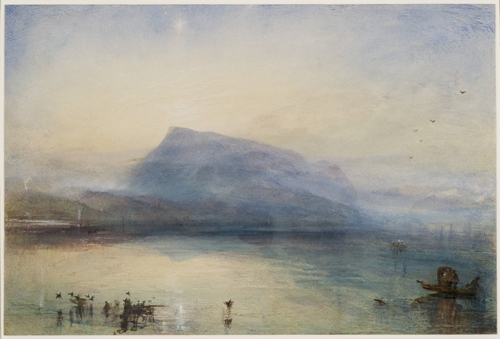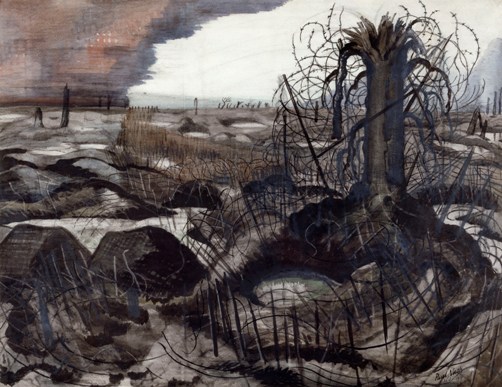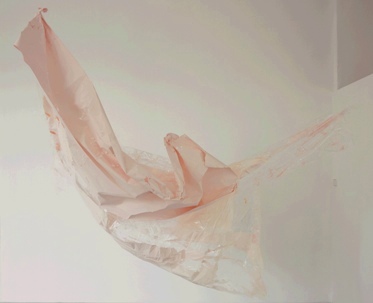Watercolour, Tate Britain | reviews, news & interviews
Watercolour, Tate Britain
Watercolour, Tate Britain
An exhibition so eager to overturn preconceptions that it forgets itself
Does watercolour painting suffer from an image problem? Do you think of the wild, vaporous seascapes of Turner, or Victorian ladies at their sketchbooks dabbing daintily at wishy-washy flower paintings? Do you associate the medium with radical innovation or with staid tradition? And would Jackson Pollock have appeared quite so heroic flinging thin washes of watercolour around instead of viscous oils?
The curators at Tate Britain certainly think there’s a problem with perception, so they want us to lay down whatever preconceptions we might have of watercolour simply being the medium of choice for the happy amateur and to explore its unique and malleable properties. After all, great artists down the centuries have produced works comparable in power – arguably – to their work in oils. Turner harnessed its luminous qualities in paintings such as The Blue Rigi, Sunrise, 1842 (pictured below right), a magnificent meditation on varying light and colour effects. And what’s more, it’s the artists of this country who are widely acknowledged as watercolour’s greatest exponents.
 Why should that be? This exhibition, which features over 200 works, sets out to explore this question and begins with the medieval illuminated manuscript. The jewel-bright opaque colours in these early illustrations show little of how the medium will come to be used as a way of conveying spontaneity. For that it will have to wait a few centuries. Compare, for instance, a landscape painted by the Antwerp-born Van Dyck in 1635-41 (A Coastal Landscape with Trees and Ships) with that painted by the English artist John Dunstall, A Pollard Oak near Hampnett Place, Chichester (main picture), some two decades later. The earlier painting is beautifully fluid and free, and though Dunstall’s picture is rather beautiful in its own way it does look incredibly naïve and antiquated by comparison.
Why should that be? This exhibition, which features over 200 works, sets out to explore this question and begins with the medieval illuminated manuscript. The jewel-bright opaque colours in these early illustrations show little of how the medium will come to be used as a way of conveying spontaneity. For that it will have to wait a few centuries. Compare, for instance, a landscape painted by the Antwerp-born Van Dyck in 1635-41 (A Coastal Landscape with Trees and Ships) with that painted by the English artist John Dunstall, A Pollard Oak near Hampnett Place, Chichester (main picture), some two decades later. The earlier painting is beautifully fluid and free, and though Dunstall’s picture is rather beautiful in its own way it does look incredibly naïve and antiquated by comparison.
Dunstall was still using the techniques mastered by medieval manuscript illuminators and it wasn’t until the very late 18th century and the early years of the 19th century that we see watercolourists begin to enjoy its unique qualities. Difficult to master, yet easier to use than oils, not least because water-based paint dries quickly and is easily portable (with only an additional sketchbook needed), it became the medium of choice for artists painting rapidly in the rugged outdoors. The golden age of artists such as Thomas Girton and Francis Towne had arrived.
 Taking a thematic rather than a strictly chronological approach, we pass from sections entitled "Travel and Typography" to "Inner Vision" and "Abstraction and Improvisation". The exhibition takes in a range of techniques, from loose and shimmering washes of translucent colour to precise draughtsmanship. There’s a great section on artists and war, which includes Wire, 1918-19 (pictured left), a dark and powerfully haunting painting of a desolate, scarred landscape by Paul Nash, an official war artist on the Western Front during World War One, as well as surgical portraits of facially disfigured soldiers, painted as medical documents rather than works of art.
Taking a thematic rather than a strictly chronological approach, we pass from sections entitled "Travel and Typography" to "Inner Vision" and "Abstraction and Improvisation". The exhibition takes in a range of techniques, from loose and shimmering washes of translucent colour to precise draughtsmanship. There’s a great section on artists and war, which includes Wire, 1918-19 (pictured left), a dark and powerfully haunting painting of a desolate, scarred landscape by Paul Nash, an official war artist on the Western Front during World War One, as well as surgical portraits of facially disfigured soldiers, painted as medical documents rather than works of art.
 These hold their own fascination, but the exhibition is so eager to get away from any association of tweeness that it often forgets some of the greatest exponents of watercolour painting during this period. I would have loved to have seen Gwen John’s exquisite miniatures of her beloved cats, for instance, because they too possess a singularity of vision as rich and as deep as anything we encounter in this exhibition. And yet she is overlooked for works by lesser and often little-known artists. Furthermore, the exhibition ends rather bizarrely, not with a painting but with a ragged installation of roughly daubed cellophane which hangs like a flimsy, crinkled hammock between two walls – or, rather aptly, like a great, deflated balloon. At the very least I would have said that the use of watercolour in Karla Black’s Opportunity for Girls, 2006 (pictured above right), is incidental rather than integral to the work. In any case, it’s a sorry way to end an exhibition that begins with such promise.
These hold their own fascination, but the exhibition is so eager to get away from any association of tweeness that it often forgets some of the greatest exponents of watercolour painting during this period. I would have loved to have seen Gwen John’s exquisite miniatures of her beloved cats, for instance, because they too possess a singularity of vision as rich and as deep as anything we encounter in this exhibition. And yet she is overlooked for works by lesser and often little-known artists. Furthermore, the exhibition ends rather bizarrely, not with a painting but with a ragged installation of roughly daubed cellophane which hangs like a flimsy, crinkled hammock between two walls – or, rather aptly, like a great, deflated balloon. At the very least I would have said that the use of watercolour in Karla Black’s Opportunity for Girls, 2006 (pictured above right), is incidental rather than integral to the work. In any case, it’s a sorry way to end an exhibition that begins with such promise.
Add comment
The future of Arts Journalism
You can stop theartsdesk.com closing!
We urgently need financing to survive. Our fundraising drive has thus far raised £49,000 but we need to reach £100,000 or we will be forced to close. Please contribute here: https://gofund.me/c3f6033d
And if you can forward this information to anyone who might assist, we’d be grateful.

Subscribe to theartsdesk.com
Thank you for continuing to read our work on theartsdesk.com. For unlimited access to every article in its entirety, including our archive of more than 15,000 pieces, we're asking for £5 per month or £40 per year. We feel it's a very good deal, and hope you do too.
To take a subscription now simply click here.
And if you're looking for that extra gift for a friend or family member, why not treat them to a theartsdesk.com gift subscription?
more Visual arts
 'We are bowled over!' Thank you for your messages of love and support
Much-appreciated words of commendation from readers and the cultural community
'We are bowled over!' Thank you for your messages of love and support
Much-appreciated words of commendation from readers and the cultural community
 Emily Kam Kngwarray, Tate Modern review - glimpses of another world
Pictures that are an affirmation of belonging
Emily Kam Kngwarray, Tate Modern review - glimpses of another world
Pictures that are an affirmation of belonging
 Kiefer / Van Gogh, Royal Academy review - a pairing of opposites
Small scale intensity meets large scale melodrama
Kiefer / Van Gogh, Royal Academy review - a pairing of opposites
Small scale intensity meets large scale melodrama
 Jenny Saville: The Anatomy of Painting, National Portrait Gallery review - a protégé losing her way
A brilliant painter in search of a worthwhile subject
Jenny Saville: The Anatomy of Painting, National Portrait Gallery review - a protégé losing her way
A brilliant painter in search of a worthwhile subject
 Abstract Erotic, Courtauld Gallery review - sculpture that is sensuous, funny and subversive
Testing the boundaries of good taste, and winning
Abstract Erotic, Courtauld Gallery review - sculpture that is sensuous, funny and subversive
Testing the boundaries of good taste, and winning
 Edward Burra, Tate Britain review - watercolour made mainstream
Social satire with a nasty bite
Edward Burra, Tate Britain review - watercolour made mainstream
Social satire with a nasty bite
 Ithell Colquhoun, Tate Britain review - revelations of a weird and wonderful world
Emanations from the unconscious
Ithell Colquhoun, Tate Britain review - revelations of a weird and wonderful world
Emanations from the unconscious
 Rachel Jones: Gated Canyons, Dulwich Picture Gallery review - teeth with a real bite
Mouths have never looked so good
Rachel Jones: Gated Canyons, Dulwich Picture Gallery review - teeth with a real bite
Mouths have never looked so good
 Yoshitomo Nara, Hayward Gallery review - sickeningly cute kids
How to make millions out of kitsch
Yoshitomo Nara, Hayward Gallery review - sickeningly cute kids
How to make millions out of kitsch
 Hamad Butt: Apprehensions, Whitechapel Gallery review - cool, calm and potentially lethal
The YBA who didn’t have time to become a household name
Hamad Butt: Apprehensions, Whitechapel Gallery review - cool, calm and potentially lethal
The YBA who didn’t have time to become a household name
 Bogancloch review - every frame a work of art
Living off grid might be the meaning of happiness
Bogancloch review - every frame a work of art
Living off grid might be the meaning of happiness

Comments
...